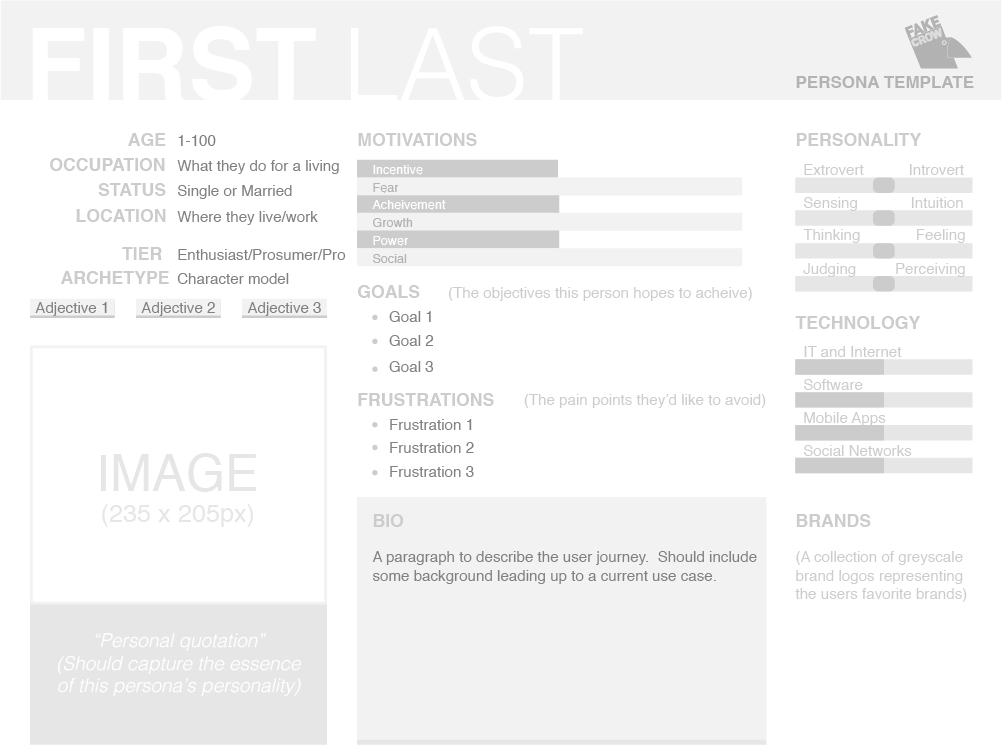User Persona: Getting Started
A user persona can be a powerful analytical tool, if it’s done thoughtfully. But it’s something we regularly struggle to persuade startup founders to do with any enthusiasm.
That’s not surprising, really. Building a user persona can seem like voodoo, if you don’t appreciate the point of doing them. Or, it can feel like a kind of homework- something you have check off the list in order to get on with the really good stuff, which is building your product into something you can be proud of. But fear not- it’s neither voodoo nor homework. It can be fun, and more importantly, it’s extremely helpful in making you a better team, and a smarter company.
What is a User Persona?
Definitions vary, but here’s the one that I think is most useful for early-stage startups: a persona is essentially a description of your ideal customer. It includes general and detailed information about that user’s motivations, their goals, their situation in life, and the type of person they are.
Some user personas are written as a kind of narrative, including fanciful details to make the person feel more real. Others are utilitarian, like a government file or a social media profile.
While many templates and types of personas exist, the most important point is that they provide your team a target for their sales, marketing, UX, and design goals. Your user personas, particularly for startups, serve as a kind of ur-user; a face, name, and personality you keep in mind when you are working towards releasing a product.
Whatever format makes that most accessible and useful is ok to use, but we will also talk more about format later on.
What a User Persona is Based On
In a startup without any customers, or even without a finished product, it’s not always clear how to get started with a user persona. Who are your ideal customers? Since you don’t have any yet, it’s hard to say.
Should your personas be based on real people? Yes, and no. For a lot of startups, a “best guess” is necessary to get you started. This is often called a “proto-persona,” and it deals more with the basic needs and goals of a user, than with the specific ux expectations that user might have.
If you’re very familiar with the market segment you’re targeting, you can use that experience to construct a composite of the type of user who will buy or use your product. This is usually easier if the product is for professionals or a specific user-segment, because it will likely be based on some existing industry experience.
Say, for example, you’re building a Saas product for professional translators. You probably know a bit about that industry, and the types of people who need your solution. A composite of people you already know can serve as a jumping off point for your user-persona.
Again, the idea is to composite an “ideal” candidate user. This is the person who will be your best customer, and will gladly buy from you. They are the perfect fit for your product. Though most customers won’t fit that mold exactly, a persona should help you steer your efforts towards the people who will want to use (and pay to use) your product most.
You can also find relatively cheap ways of doing market research, such as conducting broad social media campaigns, or a survey, and analyzing the users who fill out the survey, or convert on your landing pages, or who like the posts on your Facebook page.
You are Not your User
These educated guesses can give you an overall view of who is responding most to your product, but keep in mind, the composition of that group will be dependent on the communication of the campaign as well.
Many startups start out thinking that their typical users are basically analogues of themselves. This is most common in startups where the founders might actually be very similar to their eventual customers, because the startup is based on a specific hobby, or interest. It can lead you to many false conclusions about who your ideal customer really is. Many male startup founders, for example, undervalue the appeal of their products to women, and so ignore evidence that women are interested in their products.
Jakob Nielsen, the influential usability expert, puts it this way in Growing A Business Website:
“One of usability’s most hard-earned lessons is that ‘you are not the user.’ If you work on a development project, you’re atypical by definition. Design to optimize the user experience for outsiders, not insiders.”
The lesson extends beyond usability, to marketing, feature design, and many other areas. A very compelling reason for building a user persona is to challenge your assumptions against future evidence, including user testing and user feedback.
If you find, after some period of time, that your user persona isn’t lining up very well with the reality of your sales results, then it might be time to adjust the persona. You may find that the early adopters from that unexpected segment reveal an untapped demand among users like them, who are not early adopters.
If you don’t have a user persona to work with, then you don’t have anything to challenge your assumptions with. New user behavior is just noise without clear context. Why are certain types of users attracted to your product? How can you get more of those types of users? It will be difficult to figure out where to start.
What a User Persona Looks Like
You’ll find many examples of user personas online, and many twists on the basic pattern. You don’t have to stick with any one of those. There are no rules. But your format should compliment your goals in creating a persona. What will this persona help you to do? Will it be used to shape your marketing message? Will it dictate what features you plan? Will it influence the design?
Hopefully, you have a range of goals you need to accomplish, and the user persona is a kind of benchmark. You can refer back to him or her (they can have a name and everything), and ask yourself and your team: “Is John really interested in this feature?” or “will Jackie really respond to that kind of email?” In time, you can add real observations of your users to flesh out this fictional person. Your team can become familiar with them and their issues and goals.
A format I really like, for its clarity and ease of use, is this one, from fakecrow.com (a service for creating user personas):
The persona is laid out less like a story than a file on an existing person. The kind of thing you might see in a spy movie. It also allows you and your team to see a big picture representation of a person from many angles: what they do for work, what their personal life is like, what kind of technology they use, and what kind of personality they have. Each data point can be a discussion topic, and a test of your own thinking about the product.
Most startups should challenge them to create at least 3 different personas, and test them in the real world, either through marketing, or in person testing of people who match the profile as closely as possible.
Keep in mind, your goal at the beginning is not to find out what is most typical or most common, but which type of user is ideal for you. Usually, that’s the person most ready and able to buy your product. This early testing of your user persona can reveal whether or not the persona you are targeting is in fact ideal.
Don’t Chase the Rabbit
As in all things, moderation is important here too. Your user persona is never perfect, and never complete. The goal of this process is not to nail down the perfect user, and then lock that into your team’s mindset for all time. Circumstances, economics, and technology change at a rapid pace. What was important to a lot of people 10 years ago, is now much less important. You have to keep your user persona updated and in line with reality, so don’t get too deep into this analytical process before getting into real-life contact with real users.
That said, devote some time as early as you can to creating multiple personas, and let that process influence how you approach the market from the beginning. It’s ok to be wrong- in fact, it’s necessary to be wrong at least some of the time. If you don’t make any mistakes, it’s probably because you aren’t taking any risks, and in startups, a certain amount of risk is advisable on the path to a truly disruptive and effective new product.






